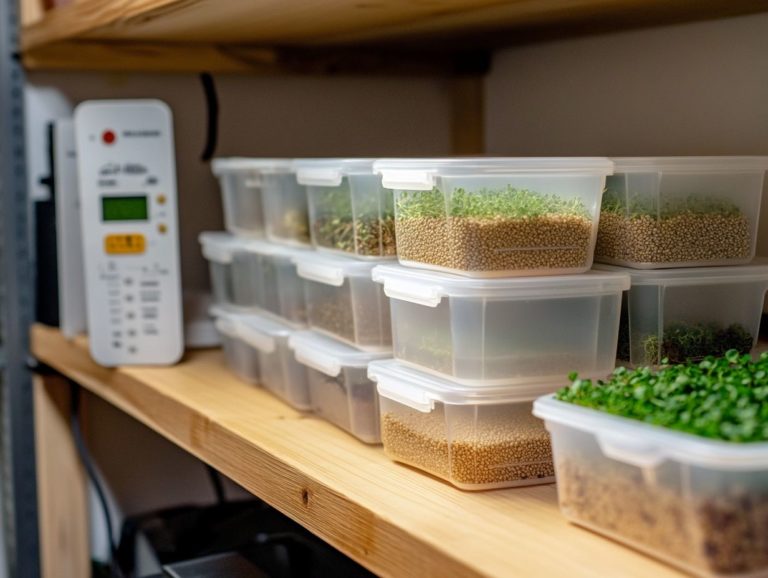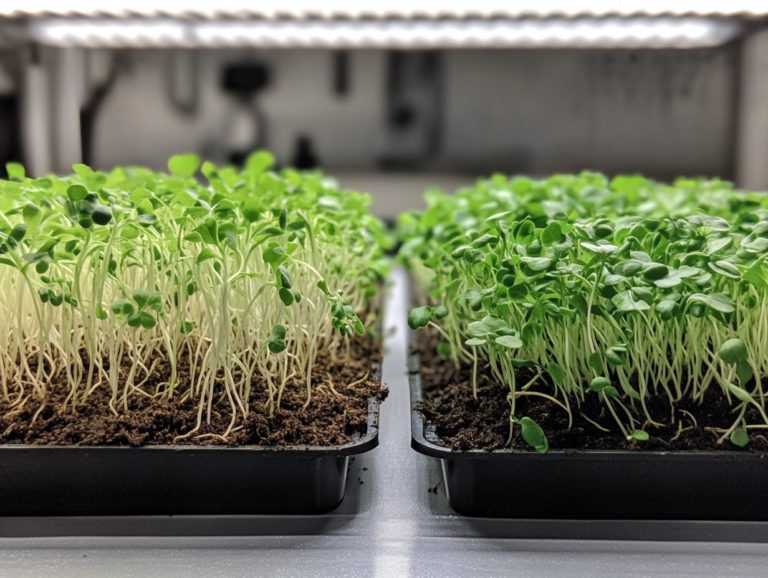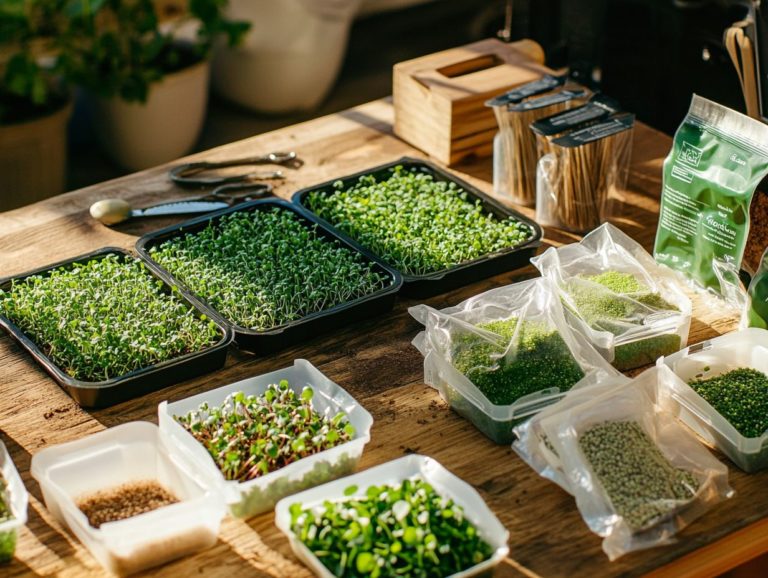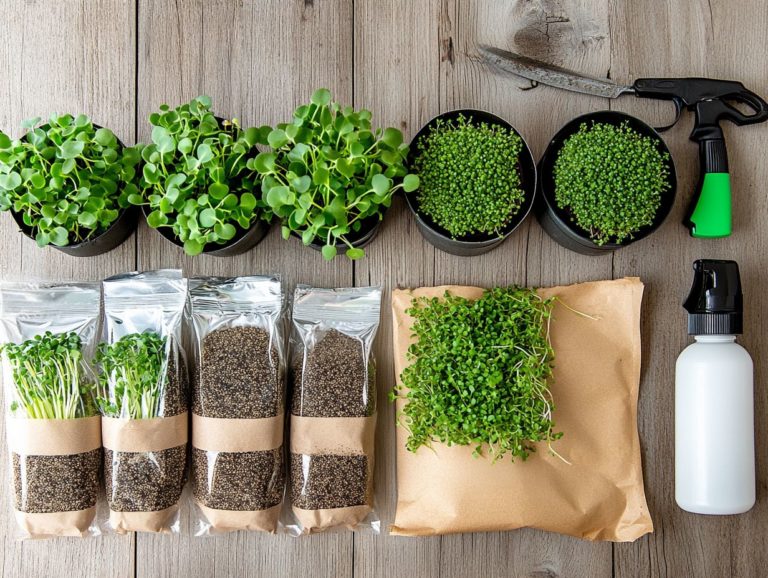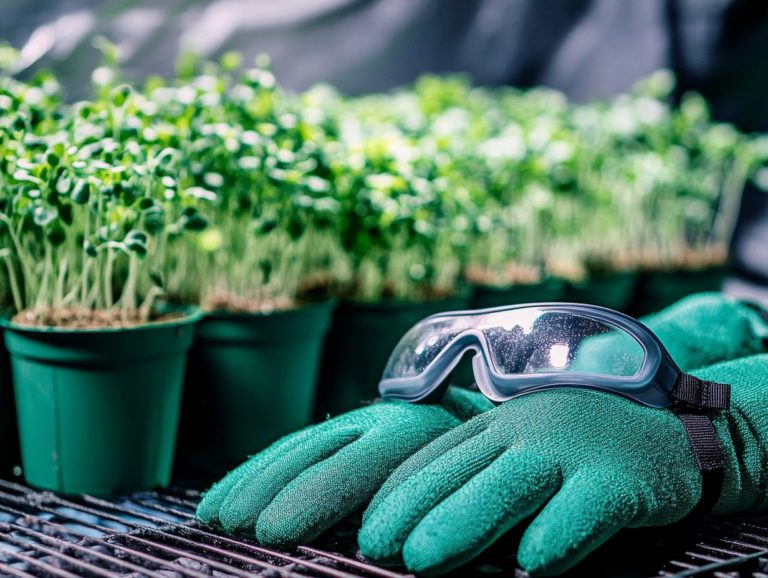Essential Lighting Tips for Microgreen Growth
Good lighting is your secret weapon for growing delicious microgreens! It influences everything from germination to flavor profile.
You must understand light exposure to unlock your microgreens’ full potential this includes aspects like intensity and duration. By grasping the differences between natural and artificial light, as well as the importance of the light spectrum, you can elevate your microgreen gardening experience.
This guide walks you through ideal lighting setups, helps you troubleshoot common issues, and provides essential tips for optimizing light intensity and balance.
Whether you re just starting out or are a seasoned grower, mastering the art of lighting can profoundly enhance your microgreen yields.
Contents
Key Takeaways:
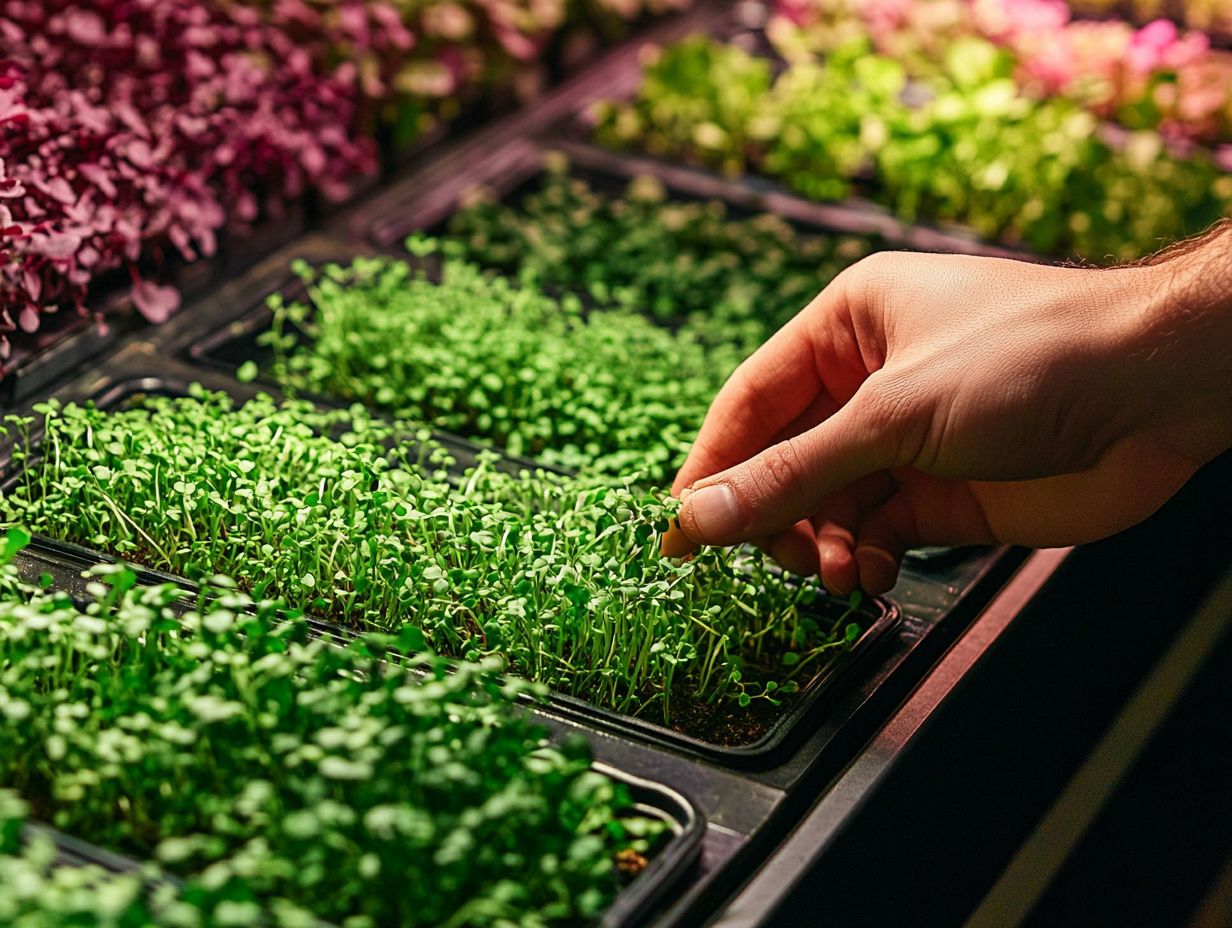
- Proper lighting is essential for microgreen growth as it provides the necessary energy for photosynthesis and influences plant growth and development.
- Natural light is preferred for microgreens, but artificial light can also be used with the right light spectrum and setup.
- To ensure optimal growth, microgreens should be positioned at the right distance from the light source, with careful monitoring of light intensity and duration.
The Importance of Lighting for Microgreens
Lighting is crucial for cultivating microgreens, directly influencing their growth, flavor, and nutritional content. You must understand light exposure to optimize your indoor gardening setup.
Whether you opt for natural sunlight or sophisticated LED grow lights, the quality and type of light will boost your microgreens’ growth cycles and overall harvest yield. Implementing effective lighting systems is vital for maximizing plant growth.
Understanding the Role of Light in Growth
The role of light in plant growth is essential, especially for microgreens, as it powers photosynthesis the process that allows plants to transform light energy into chemical energy.
Several factors influence this vital process. Light intensity is paramount; it dictates the amount of energy available for photosynthesis. Light duration, or photoperiod, plays a crucial role in determining the timing and pace of growth. Understanding photosynthetic photon flux, which measures the amount of light plants receive in a specific area, is key.
By grasping these elements, you can significantly enhance your cultivation practices for microgreens, optimizing conditions that foster robust growth and vibrant health.
Types of Lighting for Microgreens
Choosing the right type of lighting is essential for creating the best growth conditions and maximizing your yield. You have several options LED lights, fluorescent grow lights, and even natural sunlight each with its own set of advantages and drawbacks.
Understanding the nuances of light spectrum and the significance of full-spectrum lighting will help you make informed decisions tailored to your needs. The lighting technology you select influences energy efficiency and light distribution, both crucial for successful microgreen cultivation. To enhance your results, consider exploring how to maximize yields from microgreens.
Natural vs Artificial Light
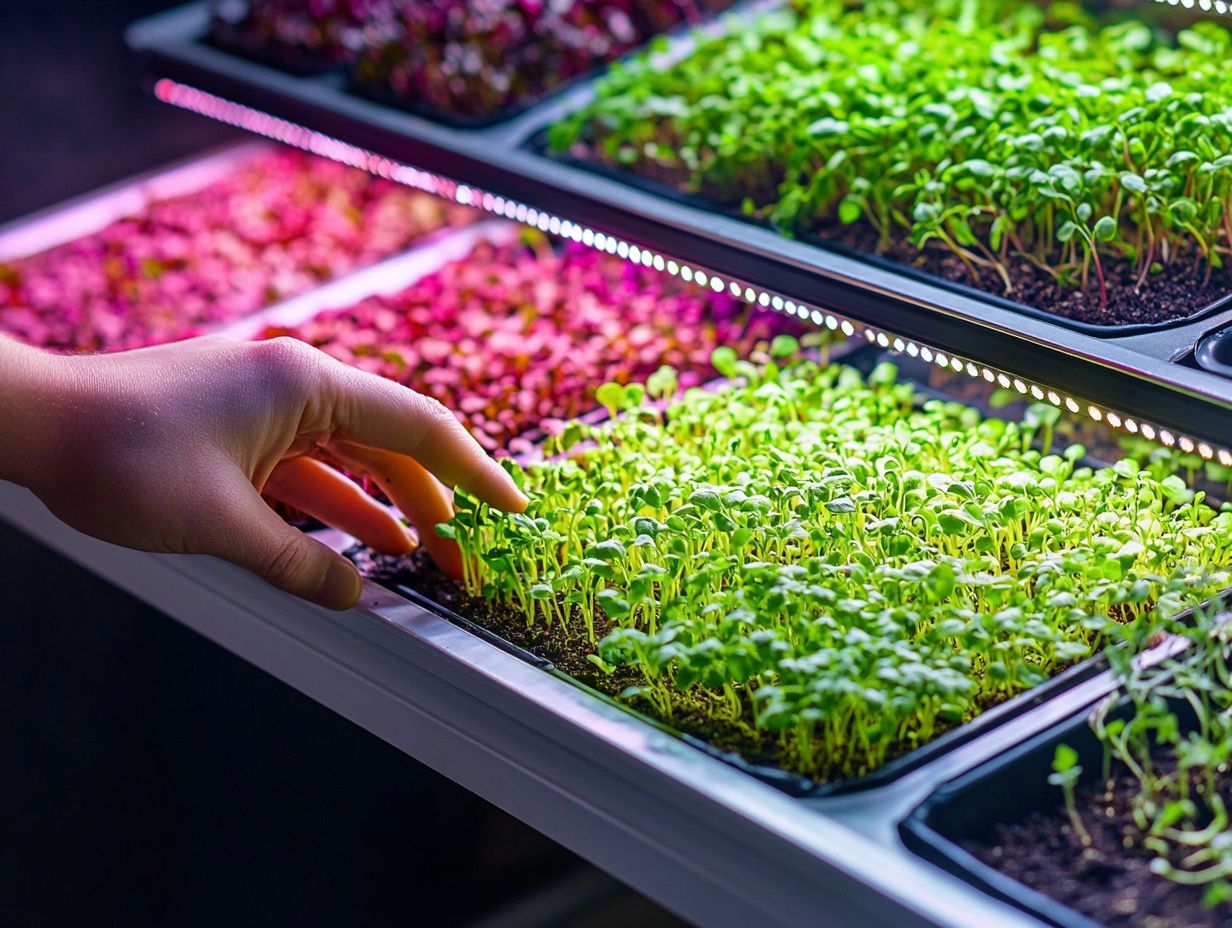
Natural light and artificial light are your two primary sources of illumination for cultivating microgreens. Each brings its own distinct advantages and challenges to your gardening experience.
Natural sunlight offers a full spectrum of wavelengths that fosters vigorous growth by enhancing photosynthesis. It also elevates the flavor and nutrient density of your plants.
On the flip side, artificial lighting like LED and fluorescent grow lights gives you remarkable flexibility in placement and timing. You can customize grow lights for specific growth stages, ensuring optimal conditions when sunlight falls short, especially during those dreary winter months.
It’s crucial to weigh the efficiency and environmental impact of each lighting option. Natural light is sustainable but fluctuates with the seasons. Artificial lights guarantee consistent growth but may lead to increased energy consumption. For those facing challenges, troubleshooting common microgreen growth issues can be invaluable. Making an informed decision sets you on the path to thriving microgreens.
Choosing the Right Light Spectrum
Picking the right light is the secret sauce to thriving microgreens! Different wavelengths of light can profoundly influence plant health and development.
To promote optimal growth, it’s essential to understand the warmth or coolness of light, which is measured in Kelvin. For example, blue light, typically within the 5000-6500K range, boosts vegetative growth and strengthens leaf development. This light is vital during the initial stages of cultivating your microgreens, and understanding the role of temperature in microgreen growth can further enhance your success.
The warmer red spectrum, usually ranging from 2700-3000K, encourages flowering and fruiting. By using full-spectrum lighting that mimics natural sunlight, you ensure your plants receive a well-rounded array of colors. This sets the stage for healthier yields and enhanced flavors.
So, selecting the right microgreen lights for these growth stages makes a big difference in your journey to cultivate thriving greens.
Lighting Set-Up for Microgreens
Establishing an effective lighting system is crucial for creating the ideal growing conditions for your microgreens. Thoughtfully placing and covering your light sources can significantly enhance both plant health and yield.
As a home grower, it s essential to grasp the nuances of light conditions to ensure every microgreen grows strong and healthy throughout your trays.
Consider factors like the distance of your light sources, wattage, and overall light distribution to craft an efficient growing setup. Doing so achieves better light management, ultimately resulting in nutrient-dense greens that thrive.
Positioning and Distance
The positioning and distance of grow lights from your microgreens are crucial elements that impact both light intensity and overall growth.
Proper placement is vital for adequate light distribution while avoiding the pitfalls of excessive radiant heat. If your lights are too close, the heat can stress the plants and hinder photosynthesis, negatively affecting their health.
On the other hand, if the lights are too far away, you risk reducing light intensity, resulting in weak and leggy growth. By observing how your plants respond to different distances and making adjustments as needed, you can significantly boost their vitality.
Grasping these dynamics allows you to fine-tune your setup for maximum yield. Get your lights right, and watch your microgreens flourish!
Timing and Duration
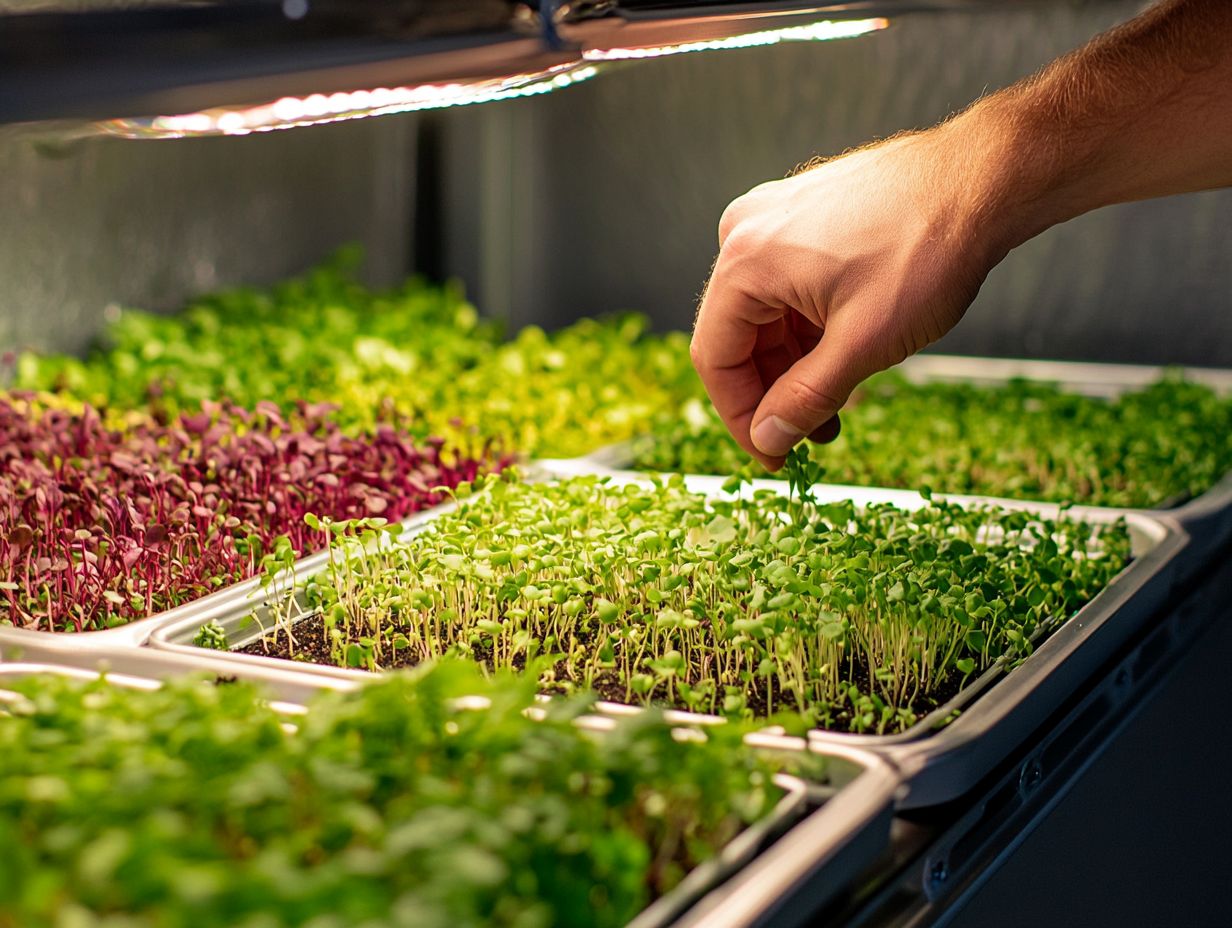
Establish appropriate light cycles. The timing and duration of light exposure are crucial elements in successfully cultivating microgreens and significantly influence their growth cycles and overall health.
Maximize photosynthesis and create an environment where these delicate plants can truly thrive by balancing light intensity with exposure duration. Ensure your microgreens receive ample energy throughout the day while mimicking the natural rhythm of sunlight. For detailed insights, check out the perfect light conditions for microgreens.
Meticulously scheduling light and dark periods can effectively influence the way plants absorb nutrients, enhancing their overall vigor. This leads to more robust harvests. Mastering light management is key to thriving microgreens.
Fixing Lighting Problems
Troubleshooting lighting issues is essential for cultivating thriving microgreens. When light management isn t handled properly, it can lead to a range of common problems that hinder plant growth.
Common Problems and Solutions
Common issues with lighting can include inadequate light intensity, uneven exposure, and excessive heat. These challenges can negatively impact the growth of your microgreens.
Such problems can lead to stunted growth, lackluster color development, and reduced nutrient content in your microgreens. It is crucial to identify and resolve these issues swiftly.
Inadequate light intensity often stems from using bulbs that are either too weak or positioned too far from the plants. Uneven exposure might result from poor placement or shading from nearby structures.
Excessive heat from certain lighting sources can be detrimental to your delicate microgreens, causing them to wilt or develop scorched leaves. Implement solutions such as adjusting light distance, utilizing adjustable spectrum LED bulbs, or incorporating heat sinks to improve the growth environment. For additional tips, consider how to extend the growing season for microgreens. This nurtures healthier plants and ultimately leads to better yields.
Lighting Tips for Optimal Microgreen Growth
For the best microgreen growth, implement effective lighting strategies that strike the perfect balance between light intensity and duration. Adhere to energy-efficient practices using affordable lights to achieve nutrient-rich greens.
Proper Light Intensity and Balance

Maintaining the right light intensity and balance is essential for elevating photosynthesis and ensuring the overall health of your microgreens. This is particularly crucial during various growth stages and growing cycles, as each phase requires specific light levels to optimize growth and nutrient absorption.
For example, seedlings need lower light intensity and light quality to prevent stress, while mature microgreens flourish under higher levels of light intensity. To better understand this process, exploring the science behind microgreen growth can provide effective strategies to monitor these light conditions, such as using light meters (which measure light intensity) or spectrometers (which analyze light quality) to yield valuable insights for making necessary adjustments.
Utilizing timers for controlled light exposure, along with considering adjustable LED systems or grow lights, can help create the perfect environment. This thoughtful approach will ultimately lead to essential tips for growing microgreens at home that are robust, rich in nutrients, exhibit vibrant colors, and increase your yields.
Additional Factors to Consider
Along with light intensity and duration, you’ll find that several other factors significantly influence the successful growth of microgreens, including light conditions and the radiant heat from your grow lights and lighting systems.
Humidity levels and air circulation have a huge effect on how healthy your plants grow. High humidity might invite unwelcome mold and fungal issues.
Insufficient airflow can lead to stunted growth. For effective microgreen cultivation at home, it’s essential to monitor these environmental conditions regularly. Utilizing fans that move back and forth or grow rack setups can boost air circulation, while a humidity tray and proper light distribution can help you achieve the perfect balance.
Temperature control is also vital, as microgreens often flourish best in a stable environment between 65 F and 75 F.
By thoughtfully managing these factors, you can enhance your microgreen yields and cultivate a thriving indoor garden that truly impresses. For example, learning How to Use Hydroponics for Microgreens can lead to amazing growth when paired with careful monitoring!
Frequently Asked Questions
What are some essential lighting tips for microgreen growth?
- Ensure your microgreens are receiving enough light by placing them in a location with bright, indirect sunlight.
- If natural sunlight is not available, consider using LED grow lights that provide all the colors of light plants need to provide the necessary light spectrum for growth.
- Keep the light source about 6-8 inches away from the microgreens to prevent burning or wilting.
- Use a timer to give your microgreens consistent light for 12-16 hours a day, mimicking natural daylight hours.
- Rotate your microgreens regularly to ensure all sides receive equal amounts of light and prevent them from leaning towards the light source.
- Avoid leaving the lights on 24/7, as this can disrupt the natural growth cycle of the microgreens and may hinder their growth.
Start your microgreen journey today!

